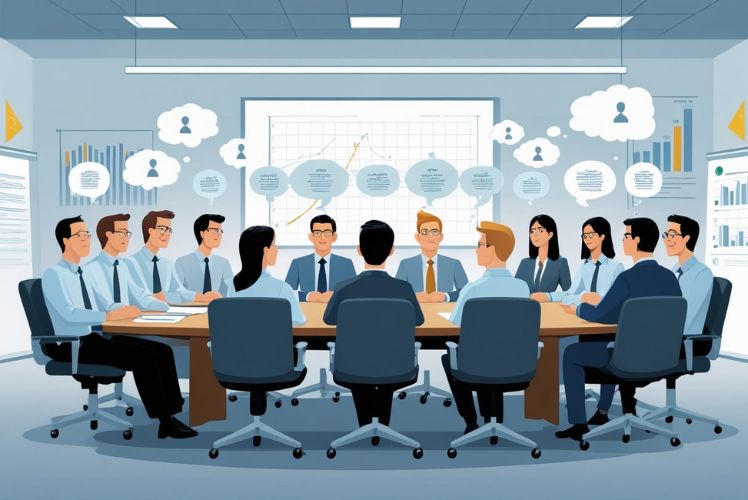The groupthink cognitive bias can shape our group decisions in ways we do not always notice. Groupthink happens when our need for group harmony overrides our ability to think critically or consider different ideas. This can lead us to agree with the majority, even if it means going against our own judgement or ignoring important information.

When we work in teams, it feels safer to agree than to challenge the group, but this can cause poor decisions or missed warning signs. From history’s big mistakes to everyday workplace blunders, groupthink has contributed to many problems that could have been avoided with open discussion and honest feedback.
Key Takeaways
- Groupthink makes us value agreement over critical thinking.
- This bias can lead to risky or poor decisions in groups.
- Encouraging open discussion helps prevent groupthink.
Understanding the Groupthink Cognitive Bias

Groupthink is a type of cognitive bias that affects how we make decisions as a group. It often leads us to prioritise agreement or harmony over critical thinking and making the best choices.
Definition and Origins
Groupthink is a psychological phenomenon where members of a group strive for consensus, sometimes at the cost of their own ideas or opinions. When we experience groupthink, we may ignore alternative viewpoints, suppress doubts, and even agree with decisions we privately believe are unwise.
This bias is most likely to happen when the group values harmony or belonging more than accuracy. It is common in situations where disagreement might lead to conflict or discomfort. In such cases, people may avoid expressing concerns to avoid standing out.
Groupthink can appear in any group, such as school teams, workplaces, or even governments. Social pressure, authority figures, and the desire to be liked all play a part in making groupthink more likely.
Key Characteristics
There are specific signs that a group may be experiencing groupthink:
- Members believe their group cannot make mistakes (illusion of invulnerability).
- People avoid raising uncomfortable questions or dissenting opinions.
- There is pressure on others to agree with the majority.
- Alternatives and risks are not fully discussed or are ignored.
- Criticism of group decisions is discouraged or even punished.
When these features are present, the group might make more risky, poorly evaluated, or flawed decisions. Our need to fit in or avoid conflict can override our judgement or common sense, leading us away from careful analysis and open debate.
Irving L. Janis’s Contribution
Irving L. Janis, a social psychologist, first described the groupthink cognitive bias in 1972. He wanted to explain how groups can sometimes make poor decisions, even when the people in them are intelligent and well-intentioned.
Janis identified eight symptoms of groupthink, such as illusions of invulnerability, collective rationalisation, and self-censorship. He showed how these symptoms can interact, leading groups to overlook possible dangers or ignore outside information.
Janis’s work has helped us understand that groupthink is not just about making mistakes but results from specific pressures and group dynamics. His research encourages us to promote open discussion and support critical thinking within our groups.
How Groupthink Influences Decision-Making

Groupthink changes the way groups make decisions by shaping what ideas get discussed, how group members act, and how fast groups settle on solutions. When groupthink takes over, important details are often missed or ignored, and decision quality can suffer.
Impact on Group Decisions
When groupthink is present, our group’s decisions can become narrow because we focus mainly on agreement, not on examining alternatives. This can result in limited thinking, where only a few ideas are seriously considered.
In many cases, we might avoid important questions or overlook possible risks. If the group feels excited or sure about an idea, some members may ignore signs of problems. Decision-making becomes less about facts and more about keeping everyone happy.
We might feel an illusion of being correct, even if we are missing information. This false sense of confidence can lead to poor choices, especially when we do not look at evidence from more than one side.
Suppression of Dissent
A key feature of groupthink is the silence or removal of different opinions. When we fear going against the majority, we may not share our true thoughts. This can happen because we want to protect group unity or avoid conflict.
Sometimes, members who think differently are pressured to agree with the rest. They may feel their opinions will not be valued or could even lead to them being left out. As a result, important points of view and warnings are left unspoken.
Without dissent, our group loses out on fresh perspectives and solutions. This makes it harder to spot errors or weak spots in our thinking, and that can reduce the effectiveness of our decisions.
Speed Versus Quality in Outcomes
In groupthink situations, we often try to reach agreement quickly. This rush can make us skip key steps like careful analysis or asking hard questions. Fast decision-making may seem efficient, but it often means we do not look closely at details.
Speedy choices may work in some simple cases, but for important issues, skipping steps leads to mistakes. Quality drops when group members feel pressured to decide soon rather than right.
We must balance solving problems quickly with making sure our decisions are well thought out. Taking time for review and debate helps improve the quality and strength of our decisions, even if it feels slower.
Causes and Risk Factors of Groupthink

Groupthink often develops because of a mix of social and psychological pressures. The urge for unity, how leaders guide discussions, and certain settings can all make us more likely to fall into this cognitive bias.
Group Cohesiveness
When our groups are highly cohesive, we tend to value agreement and unity above all else. In tightly knit teams, members may avoid disagreeing, even if they notice problems or errors. This can silence doubts and push us to make decisions without careful thought.
Highly cohesive groups often develop shared beliefs and norms that everyone follows. New or dissenting members may feel pressure to go along so they aren’t left out. Loyalty to the group can make us unwilling to speak up against the majority, leading us to accept the group’s view as our own.
Studies show that strong group bonds sometimes make us ignore outside advice, even when it’s reasonable. Being “one of the team” might start to matter more than being right or making the best decision.
Leadership Influence
The way group leaders act has a big impact on groupthink. When leaders express their opinions strongly, others may feel unable to challenge them.
If a leader rewards people for agreeing and punishes those who object, dissent becomes risky. In our experience, this can result in self-censorship, where we keep quiet about our doubts or concerns. Directive leadership encourages members to support the leader’s view, even if they privately disagree.
Leaders who make decisions quickly or discourage open debate make it hard for alternative ideas to surface. Over time, this shapes a climate where challenging the group seems uncomfortable or even unacceptable.
Environmental and Situational Triggers
Certain environments and situations increase the risk of groupthink. When there is time pressure, we might rush decisions and skip careful analysis. Stress or threats from the outside, such as competition or criticism, can make us value unity as a defence.
Remote or isolated groups are also at risk, since they have less access to differing views and new information. Lack of clear decision-making rules, or poor communication practices, can amplify this bias. The presence of high stakes or uncertainty can make the group rely more on consensus as a way to cope with pressure.
| Risk Factor | How It Increases Groupthink |
|---|---|
| Time Pressure | Rushes decisions, limits debate |
| Isolation | Reduces outside input |
| High Stress/Threat | Increases need for unity |
| Vague Procedures | Causes confusion, group fills gaps |
Consequences of Groupthink in Organisations

Groupthink shapes decision-making at every level of an organisation. It reduces healthy debate, encourages conformity, and can cause major setbacks or failures when diverse viewpoints are ignored.
Notable Historical Examples
Prominent company failures often tie back to groupthink. For example, before its collapse, Credit Suisse's leadership overlooked repeated warnings about risky investments and governance issues as many executives agreed with the majority and did not speak up.
In history, the Challenger Space Shuttle disaster in 1986 is a well-known example. Engineers and managers dismissed safety concerns to preserve agreement, leading to catastrophic results. These events show how groupthink can silence dissent, leading to decisions that have serious financial, ethical, or safety consequences.
Business and Workplace Impacts
In our workplaces, groupthink often surfaces during meetings or project planning. People may not question popular ideas, fearing it could hurt team unity or their own standing. This leads to unchallenged, sometimes poor or risky, decisions.
Key outcomes include missed warning signs, lack of innovation, and repeating old solutions even when they no longer fit. Groupthink also discourages critical thinking and may allow non-evidence-based practices, such as copying previous work without review. When these habits become the norm, mistakes can multiply and harm the business’s long-term prospects.
Harmful Social Effects
Beyond decision-making, groupthink can affect workplace culture. When employees feel pressured to conform, they may suppress their genuine opinions, causing dissatisfaction and stress. Team morale drops when individuals are afraid to disagree openly.
This pressure can harm diversity of thought and prevent new ideas from being shared. In health or safety settings, groupthink can increase risks as staff follow standard protocols without questioning them. When innovation and ethical practice are stifled, the organisation can miss opportunities to grow or improve.
Strategies to Prevent and Overcome Groupthink
To reduce the effects of groupthink and other cognitive biases in team decision-making, we need to use clear strategies. These include supporting critical evaluation, assigning devil’s advocates, and making space for open discussion.
Encouraging Critical Evaluation
We can help our teams avoid groupthink by creating a culture where everyone is expected to challenge ideas with respect. When we ask for feedback and insist on reviewing all options, we make it less likely for one opinion to dominate.
It helps to provide clear guidelines. For example, we can list pros and cons of every proposal and question any assumptions the group is making. Sometimes, using anonymous feedback forms lets team members speak up without fear of judgement.
We should remind ourselves and our teams that different opinions make our decisions stronger. In meetings, we might assign someone to point out possible risks or miss out areas. This helps to focus attention on gaps in our thinking.
Utilising Devil’s Advocacy
Making someone play the role of a devil’s advocate can be a strong way to spot flaws in our reasoning. We deliberately assign a team member to argue against common views, or even suggest alternative possibilities.
By rotating this role, we make sure no one feels targeted or pressured. When the devil’s advocate highlights gaps or weaknesses, we examine our arguments more closely. This reduces conformity bias because our team expects ideas to be questioned.
We should treat this as a normal part of the process—not as an attack on anyone’s suggestions. Over time, this practice helps everyone get used to critical debate and improves our overall decision-making.
Promoting Open Communication
We need open and direct communication if we want to stop cognitive bias from shaping our decisions. This means inviting questions, listening without cutting people off, and making it easy for team members to offer honest feedback.
One way is to set aside time in meetings for everyone to share their views, perhaps using a round-robin format or small groups for those less confident. We could also use digital tools for anonymous idea-sharing.
Key tips:
- Set clear expectations that all voices matter.
- Encourage regular check-ins to review progress and opinions.
- Reward team members for bringing up new ideas or concerns.
By making communication open, we support critical thinking and help prevent groupthink.
Frequently Asked Questions
Groupthink often affects how our teams make important decisions, sometimes leading to poor judgement or ignoring warning signs. We need to understand how to recognise it, how it is different from similar biases, ways to prevent it, and what sort of impact it can have.
What are typical indicators of groupthink within a team?
We may notice that team members avoid voicing concerns or questions. There can be a strong pressure to agree with the leader or majority. People who disagree might be seen as disloyal or as troublemakers.
Critical thinking may drop, with few alternatives being discussed. The team might ignore outside opinions and believe they cannot make mistakes.
How does groupthink contrast with confirmation bias?
Groupthink relates to a group’s push for consensus, even when the decision could be harmful. It is about going along with the group to avoid conflict.
Confirmation bias, on the other hand, is when we favour information that fits our existing beliefs. It is something that can happen to individuals or groups, but groupthink is specifically about group dynamics.
In what ways can groupthink be prevented in organisational decision-making?
We should encourage open debate and welcome different viewpoints. Having an outside expert or "devil's advocate" join meetings helps challenge our assumptions.
Rotating team roles and breaking large teams into smaller groups can also reduce pressure to conform. Keeping discussions structured and making it clear that disagreement is accepted can help prevent groupthink.
Can you provide classic examples that illustrate groupthink in action?
One well-known example is the 1961 Bay of Pigs invasion, where US decision-makers failed to see the risks due to a strong desire for unanimity. Another example is the Challenger Space Shuttle disaster, where engineers' warnings were ignored to maintain group harmony.
These incidents showed how groupthink can lead teams to overlook critical evidence.
What are the key differences between the psychological and sociological perspectives on groupthink?
From a psychological point of view, groupthink is driven by our desire to fit in and avoid conflict. It focuses on mental processes like fear of rejection.
The sociological view looks at the influence of group structure, hierarchy, and culture. It sees groupthink as a result of social forces and expectations within an organisation or society.
What are the primary consequences of groupthink on company performance?
Groupthink often leads us to ignore problems and overlook better solutions. Poor decision-making can result, which may harm company results or reputation.
Creativity and critical thinking may decline, making it harder to adapt to change. Teams might miss important risks and repeat mistakes if groupthink is not addressed.

















